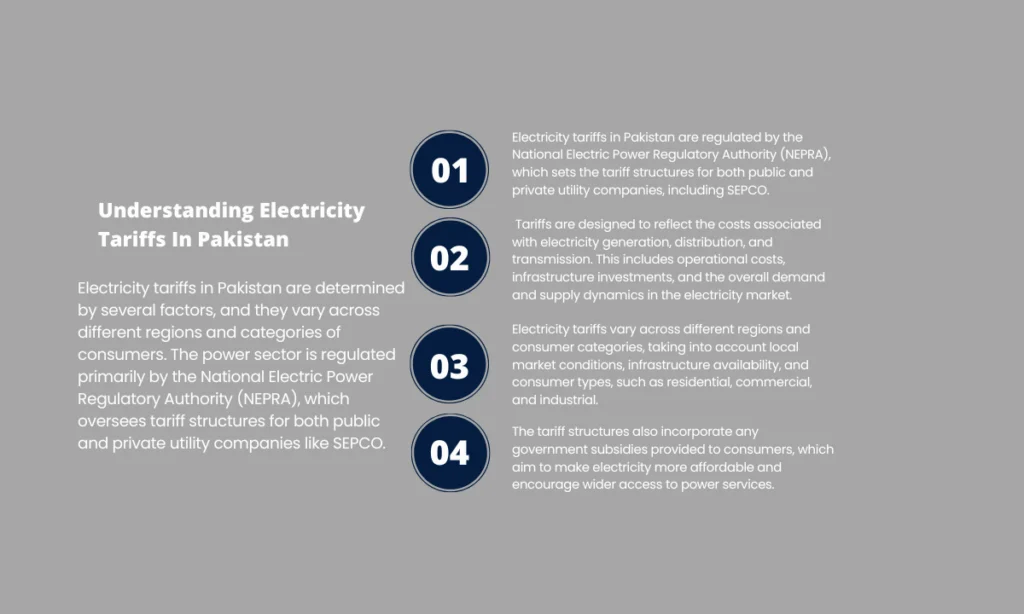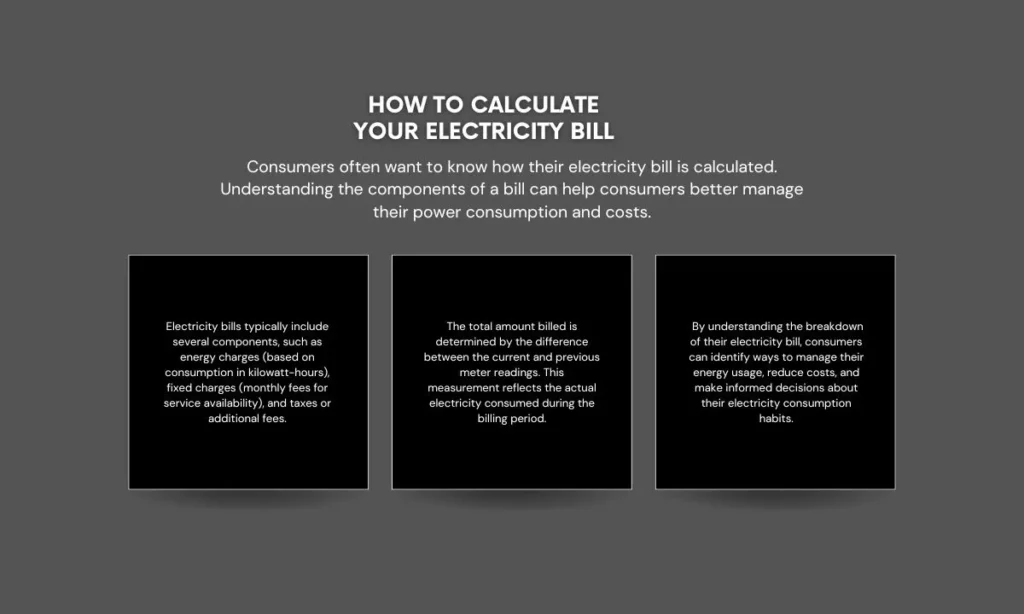Sukkur Electric Power Company (SEPCO) is a key public utility provider in Pakistan, managing electricity distribution across the northern Sindh region. Established after the unbundling of WAPDA, SEPCO serves cities such as Sukkur, Larkana, Dadu, Shikarpur, and surrounding rural areas. The company aims to ensure reliable electricity delivery, upgrade infrastructure, and reduce power theft while working under the regulatory framework of NEPRA to maintain fair tariffs.
SEPCO caters to a diverse consumer base, including residential, commercial, and industrial users, with tiered pricing to address various electricity needs. With ongoing efforts to modernize, SEPCO focuses on minimizing outages and enhancing operational efficiency to meet growing demand and improve consumer satisfaction.
Introduction to SEPCO (Sukkur Electric Power Company)Cost Per Unit Of Electricity
Overview of SEPCO
Sukkur Electric Power Company (SEPCO) is one of Pakistan’s leading public utility providers, responsible for the generation, transmission, and distribution of electricity to a wide range of consumers in the northern part of Sindh province. SEPCO was established as a distinct entity after the unbundling of WAPDA (Water and Power Development Authority), which aimed to decentralize Pakistan’s power distribution system and make it more efficient. Since its formation, SEPCO has played a pivotal role in supplying electricity to both urban and rural areas, ensuring that power reaches even the most remote regions of its coverage zone.
SEPCO is committed to enhancing the reliability of electricity supply and improving its distribution network to cope with increasing demand. The company’s infrastructure consists of substations, transformers, transmission lines, and an extensive workforce that manages operational efficiency. SEPCO also focuses on adopting modern technologies to minimize power theft, reduce line losses, and ensure a sustainable supply of electricity to its customers. The utility provider works in coordination with the National Electric Power Regulatory Authority (NEPRA) to establish fair electricity rates and improve consumer satisfaction.
Coverage Areas and Consumers
SEPCO’s service area predominantly covers the northern parts of Sindh, including key cities and towns such as Sukkur, Larkana, Dadu, Shikarpur, Jacobabad, and Khairpur. These areas represent a mix of residential, commercial, and industrial consumers, all of whom rely heavily on SEPCO for their electricity needs. The company serves a diverse population that includes urban households, rural communities, small businesses, and large-scale industries.
The consumer base of SEPCO is divided into several categories, each with its specific electricity requirements. Residential consumers form the bulk of SEPCO’s users, ranging from small homes in rural settings to high-consumption households in cities. Commercial consumers, including shops, markets, and office complexes, also form a significant part of SEPCO’s network, requiring stable power supply for their day-to-day operations. The industrial sector, though smaller in number, is a crucial part of SEPCO’s coverage, with high-energy demands for factories, mills, and manufacturing plants.
Due to the economic diversity of its coverage areas, SEPCO deals with a broad range of power distribution challenges. The company has introduced various initiatives to manage power shortages, especially in rural areas, while striving to maintain fair and transparent billing practices for its customers. Additionally, SEPCO is continuously working on upgrading its infrastructure to cope with growing demand, minimize outages, and reduce power theft, which is a common issue in certain areas of its service region.
Understanding Electricity Tariffs In Pakistan

Electricity tariffs in Pakistan are determined by several factors, and they vary across different regions and categories of consumers. The power sector is regulated primarily by the National Electric Power Regulatory Authority (NEPRA), which oversees tariff structures for both public and private utility companies like SEPCO. Tariffs are designed to reflect the cost of electricity generation, distribution, and transmission, as well as the overall demand and supply of electricity in the country. These tariffs also account for infrastructure investments, operational costs, and any subsidies provided by the government.
Factors Affecting Electricity Pricing
- Fuel Prices: One of the major components influencing electricity prices in Pakistan is the cost of fuel used for power generation. Since a significant portion of the country’s electricity is produced using fossil fuels such as natural gas, oil, and coal, fluctuations in global fuel prices directly impact the cost of electricity. Additionally, Pakistan’s reliance on imported fuel adds to the vulnerability of its energy prices.
- Generation and Distribution Costs: The overall costs of generating and distributing electricity include maintenance of power plants, upgrading transmission lines, managing grid stations, and minimizing line losses. High transmission and distribution losses due to inefficient infrastructure and power theft also contribute to higher electricity rates.
- Demand and Supply Dynamics: Seasonal variations in demand, such as increased electricity usage during the summer months, can cause fluctuations in prices. Power shortages and load-shedding in high-demand periods also lead to variations in tariffs, especially during peak hours.
- Currency Exchange Rates: Since Pakistan imports a considerable amount of fuel and equipment, the depreciation of the Pakistani rupee against the US dollar impacts electricity costs. A weaker rupee leads to higher generation costs, which, in turn, results in an increase in consumer tariffs.
- Government Policies and Subsidies: The government’s policies on power subsidies for low-income consumers, industrial relief packages, and incentives for renewable energy integration also affect pricing. The government may choose to cap prices to ensure affordability, which can alter how tariffs are structured.
Government Regulations on Power Tariffs
The government plays a critical role in regulating electricity tariffs through NEPRA, which ensures that the pricing is fair, transparent, and reflective of the true cost of power generation and distribution. NEPRA conducts regular reviews of utility companies’ financial performance, infrastructure needs, and consumer protection measures before approving any changes in tariff structures. These regulations help prevent overcharging and ensure that consumers are charged appropriately for the electricity they use.
Additionally, the government imposes taxes and surcharges on electricity bills, such as General Sales Tax (GST), Fuel Price Adjustments (FPA), and surcharges for development and maintenance of the grid. NEPRA’s role also involves ensuring that these additional costs are justified and transparent for consumers.
SEPCO Per Unit Price In 2024
In 2024, SEPCO’s per unit price structure is expected to be adjusted based on economic conditions, fuel prices, and regulatory decisions by NEPRA. SEPCO divides its rates into different categories based on the type of consumer and their energy consumption patterns. The following sections provide a detailed breakdown of these tariffs for residential, commercial, and industrial users.
Breakdown of Rates by Consumer Category
- Residential Users: SEPCO applies a tiered tariff system for residential consumers, with different rates depending on the amount of electricity consumed per month. Households consuming less electricity pay a lower rate per unit, while high-energy consumers are charged at progressively higher rates. This is designed to provide some relief to lower-income households while encouraging energy conservation among high-consuming families.
- Commercial Users: Commercial users, such as businesses, shops, and offices, are charged at higher rates than residential consumers due to their higher electricity demand. SEPCO’s commercial tariff structure reflects the need for a more consistent supply of electricity, especially for businesses that operate during peak hours when electricity demand is high.
- Industrial Users: The industrial tariff category includes factories, mills, and other large-scale manufacturing units that require large amounts of electricity. Industrial users are often eligible for special tariff relief packages provided by the government to promote industrial growth and economic development. SEPCO offers discounted rates for off-peak usage, encouraging industries to shift their operations to hours when demand is lower.
Tariffs for Peak and Off-Peak Hours
SEPCO differentiates between peak and off-peak hours to manage demand and reduce strain on the grid. Electricity prices during peak hours (typically in the evening when demand is highest) are significantly higher than during off-peak hours. This pricing strategy is designed to incentivize users, particularly large-scale industries, to consume electricity during off-peak hours to reduce overall grid congestion and stabilize supply.
Subsidies And Government Policies

The government of Pakistan, in collaboration with NEPRA, implements various subsidy schemes and tariff relief packages to ensure that electricity remains affordable for lower-income households and promote industrial growth.
Government Subsidies for Low-Income Households
To protect vulnerable segments of society, the government offers subsidies for low-income households. These subsidies reduce the financial burden on families consuming below a certain threshold of electricity (e.g., 100-300 units per month). SEPCO, as part of its social responsibility, applies these subsidies directly to consumers’ bills, ensuring that essential electricity is accessible at lower costs for economically disadvantaged families.
Tariff Relief Packages for Industrial Consumers
To stimulate economic growth and support industrialization, the government offers tariff relief packages for large-scale industrial consumers. These packages include lower electricity rates for industries operating during off-peak hours and special pricing structures for energy-intensive sectors such as textile manufacturing, steel production, and cement factories. Such measures help industries manage their costs and contribute to the nation’s overall economic output.
Taxes And Additional Charges
In addition to the base tariff rates, electricity bills in Pakistan, including those issued by SEPCO, contain various taxes and surcharges that further increase the total amount payable by consumers.
Breakdown of Taxes on Electricity Bills
- General Sales Tax (GST): A federal tax that applies to all electricity consumers. GST is calculated as a percentage of the total bill and can vary based on the consumer’s usage.
- Fuel Price Adjustments (FPA): The FPA reflects fluctuations in fuel prices that affect the cost of electricity generation. It is adjusted periodically to account for the rising or falling costs of fuel in the global market.
- Other Surcharges: SEPCO bills may also include surcharges for maintaining and upgrading the power infrastructure, improving grid stability, and other administrative costs.
Comparison with Other Power Companies
Electricity tariffs in Pakistan differ significantly between utility providers, depending on the region, infrastructure, and operational efficiency.
SEPCO vs. Other Regional Electric Companies
SEPCO’s per unit rates can be compared with other regional power distribution companies such as K-Electric, LESCO (Lahore Electric Supply Company), and MEPCO (Multan Electric Power Company). While SEPCO’s rates are generally lower than K-Electric, which operates in Karachi, it faces challenges like higher line losses and lower operational efficiency compared to companies serving more urbanized areas like LESCO.
Price Differences Across Provinces
Electricity tariffs also vary from province to province. Sindh, where SEPCO operates, tends to have slightly higher tariffs due to the infrastructure challenges and higher line losses. In contrast, more industrialized provinces like Punjab may offer lower tariffs due to a more robust grid and lower transmission losses.
How to Calculate Your Electricity Bill

Consumers often want to know how their electricity bill is calculated. Understanding the components of a bill can help consumers better manage their power consumption and costs.
Step-by-Step Bill Calculation
- Base Tariff Calculation: Multiply the total number of units consumed by the per unit price based on the applicable category (residential, commercial, industrial).
- Add Taxes and Surcharges: Add GST, fuel price adjustments, and any other surcharges that apply based on your monthly consumption.
- Adjustments for Subsidies: If eligible, subtract any government subsidies from the total bill.
Example: Residential and Commercial Billing Breakdown
For example, a residential consumer using 200 units per month will pay the base tariff for the first 100 units at a lower rate, with a higher rate applied to the next 100 units. Commercial users consuming a similar amount of electricity will pay a higher per-unit rate across all units consumed.
Future Projections And Trends
Expected Tariff Changes in 2024
Tariffs in 2024 are likely to reflect rising fuel prices and inflation, as well as efforts by SEPCO and the government to modernize the power infrastructure. While increases are expected, the government may also introduce new relief measures to protect vulnerable populations and industrial sectors.
Impact of Renewable Energy on SEPCO Tariffs
As Pakistan moves towards renewable energy integration, there may be opportunities for SEPCO to offer discounted rates for consumers who install solar panels or participate in net metering programs. The expansion of renewable energy could help stabilize long-term tariffs by reducing reliance on expensive imported fuels.
Conclusion
Summary of SEPCO Rates in 2024
In summary, SEPCO’s per unit prices in 2024 will continue to be influenced by fuel prices, government regulations, and infrastructure developments. While prices may increase, there will be efforts to manage costs through subsidies and tariff relief packages for both residential and industrial consumers.
Advice for Consumers on Managing Power Costs
Consumers are advised to monitor their electricity usage, take advantage of off-peak hours for high-energy tasks, and consider investing in energy-efficient appliances to

